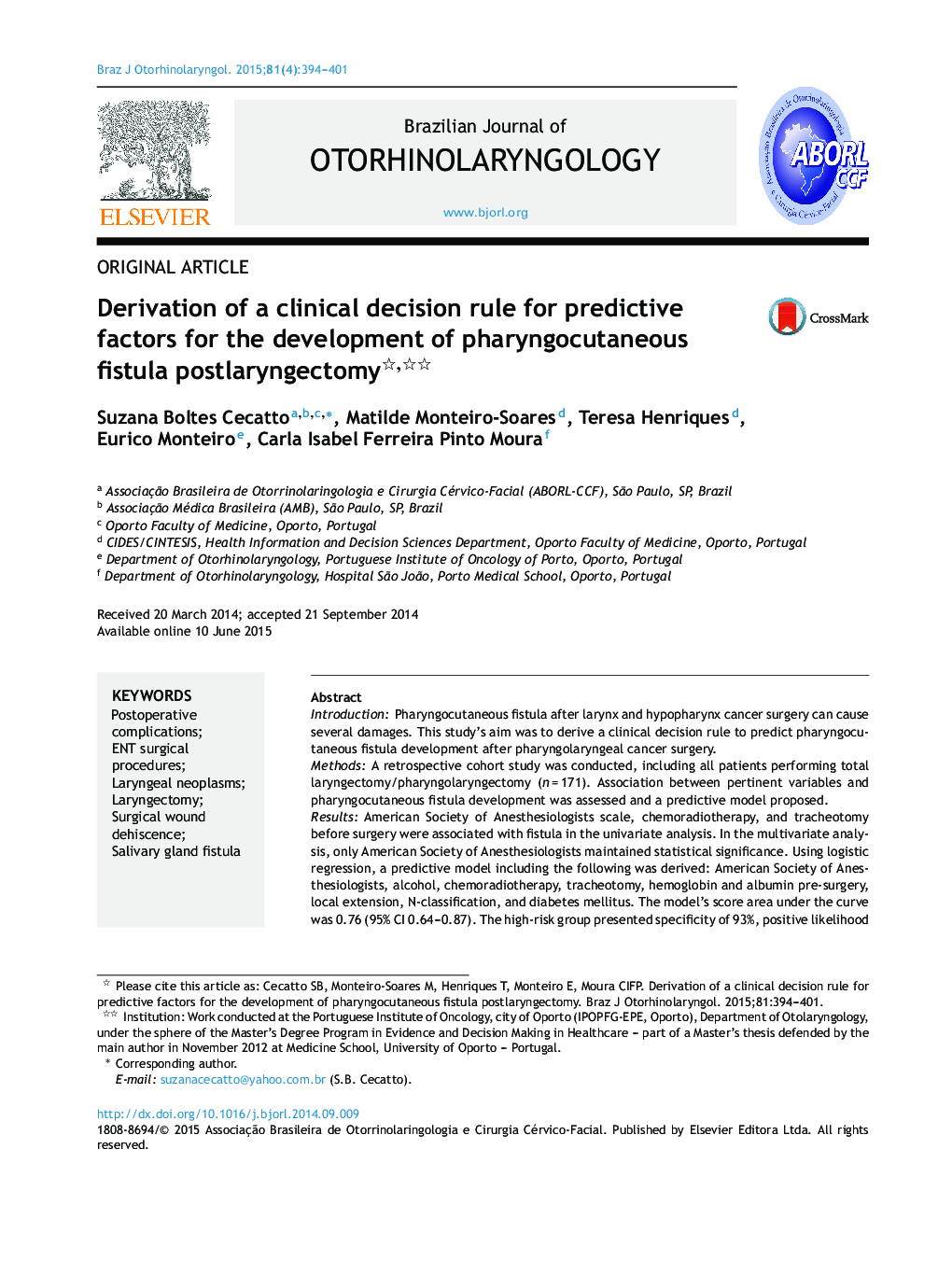| کد مقاله | کد نشریه | سال انتشار | مقاله انگلیسی | نسخه تمام متن |
|---|---|---|---|---|
| 4106307 | 1605366 | 2015 | 8 صفحه PDF | دانلود رایگان |
IntroductionPharyngocutaneous fistula after larynx and hypopharynx cancer surgery can cause several damages. This study's aim was to derive a clinical decision rule to predict pharyngocutaneous fistula development after pharyngolaryngeal cancer surgery.MethodsA retrospective cohort study was conducted, including all patients performing total laryngectomy/pharyngolaryngectomy (n = 171). Association between pertinent variables and pharyngocutaneous fistula development was assessed and a predictive model proposed.ResultsAmerican Society of Anesthesiologists scale, chemoradiotherapy, and tracheotomy before surgery were associated with fistula in the univariate analysis. In the multivariate analysis, only American Society of Anesthesiologists maintained statistical significance. Using logistic regression, a predictive model including the following was derived: American Society of Anesthesiologists, alcohol, chemoradiotherapy, tracheotomy, hemoglobin and albumin pre-surgery, local extension, N-classification, and diabetes mellitus. The model's score area under the curve was 0.76 (95% CI 0.64–0.87). The high-risk group presented specificity of 93%, positive likelihood ratio of 7.10, and positive predictive value of 76%. Including the medium-low, medium-high, and high-risk groups, a sensitivity of 92%, negative likelihood ratio of 0.25, and negative predictive value of 89% were observed.ConclusionA clinical decision rule was created to identify patients with high risk of pharyngocutaneous fistula development. Prognostic accuracy measures were substantial. Nevertheless, it is essential to conduct larger prospective studies for validation and refinement.
ResumoIntroduçãoFístula faringocutânea após cirurgia de câncer de laringe e hipofaringe causa diversos danos. Nosso objetivo foi derivar uma regra de decisão clínica (RDC) para predizer o desenvolvimento da fístula faringocutânea após cirurgia.MétodoEstudo de coorte retrospectivo incluindo todos os pacientes submetidos à laringectomia total e faringolaringectomia (n = 171). Analisou-se a associação entre as variáveis pertinentes e o desenvolvimento da fístula e foi proposto um modelo preditivo.ResultadosNa análise univariada, a ASA, quimioradioterapia (QRT) e traqueostomia antes da cirurgia foram associadas à fístula. Na análise multivariada, somente a ASA manteve-se estatisticamente significante. Por regressão logística, derivamos um modelo preditivo incluindo: ASA, álcool, QRT, traqueostomia, hemoglobina e albumina pré-operatórias, extensão local, N, DM. A curva ROC do modelo foi 0,76 (95% CI 0,64–0,87). O grupo de alto risco teve especificidade 93%, Likelihood positivo 7,10 e valor preditivo positivo 76%. Incluindo os grupos de médio baixo, médio alto e alto risco, temos sensibilidade de 92%, Likelihood negativo 0,25 e valor preditivo positivo 89%.ConclusãoCriamos uma RDC para identificar os pacientes de alto risco ao desenvolvimento da fístula faringocutânea. As medidas de acurácia prognóstica foram substanciais. Entretanto, é essencial conduzir estudos prospectivos maiores para validação/refinamento do modelo.
Journal: Brazilian Journal of Otorhinolaryngology - Volume 81, Issue 4, July–August 2015, Pages 394–401
